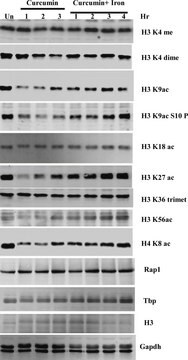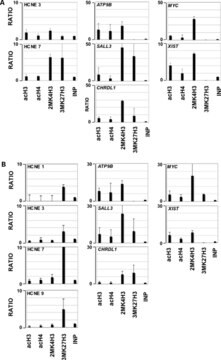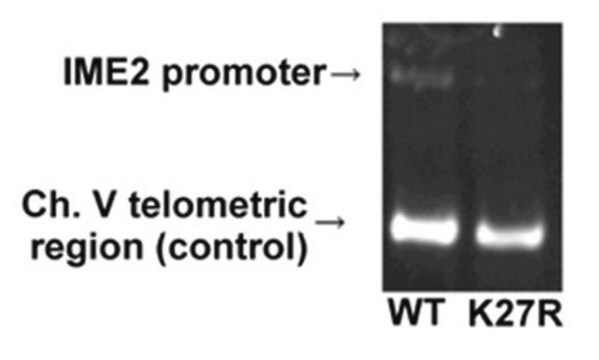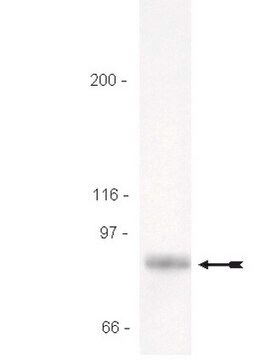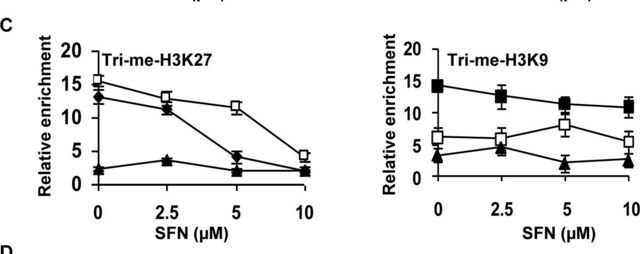07-081
Anti-phospho (Ser10)-acetyl (Lys14)-Histone H3 Antibody
Upstate®, from rabbit
Synonym(e):
H3K14me3S10P, Histone H3 (acetyl K14, phospho S10), H3 histone family, member T, histone 3, H3, histone cluster 3, H3
About This Item
Empfohlene Produkte
Biologische Quelle
rabbit
Qualitätsniveau
Antikörperform
affinity purified immunoglobulin
Antikörper-Produkttyp
primary antibodies
Klon
polyclonal
Aufgereinigt durch
affinity chromatography
Speziesreaktivität
eukaryotes, mouse, human
Hersteller/Markenname
Upstate®
Methode(n)
ChIP: suitable (ChIP-seq)
immunocytochemistry: suitable
western blot: suitable
Isotyp
IgG
NCBI-Hinterlegungsnummer
UniProt-Hinterlegungsnummer
Versandbedingung
dry ice
Posttranslationale Modifikation Target
phosphorylation (pSer10), acetylation (Lys14)
Angaben zum Gen
human ... HIST1H3F(8968)
Allgemeine Beschreibung
Spezifität
Immunogen
Anwendung
Epigenetik & nukleäre Funktionen
Histone
1:2000-1:10,000 dilutions of a previous lot detected phosphorylated and acetylated histone H3 in acid extracted proteins from serum starved mouse 10T1/2 cells treated with 50ng/ml EGF for 12.5 minutes. Western blotting of this lot to acid extracted proteins described above was preferentially competed by peptides in the following order: phospho-acetyl-H3 (7-20) > straight chain H3 (7-20) > phospho-H3 (7-20) or acetyl-H3 (7-20).
Peptide Inhibition Analysis: A 1:500 dilution from a representative lot was used with HeLa AE for peptide block analysis.
Chromatin Immunoprecipitation:
A previous lot of this antibody was reported by an independent laboratory to immunoprecipitate chromatin. (Cheung, P., 2000.)
Immunocytochemistry:
A previous lot of this antibody detected phosphorylated and acetylated histone H3 in EGF-stimulated cells; as reported by an independent laboratory. (Cheung, P., 2000.)
Qualität
Western Blot Analysis:
1:500 dilution of this lot detected phospho acetyl Histone H3 on 10 μg of HeLa acid extract.
Zielbeschreibung
Physikalische Form
Lagerung und Haltbarkeit
Handling Recommendations: Upon first thaw, and prior to removing the cap, centrifuge the vial and gently mix the solution. Aliquot into microcentrifuge tubes and store at -20°C. Avoid repeated freeze/thaw cycles, which may damage IgG and affect product performance. Note: Variabillity in freezer temperatures below -20°C may cause glycerol containing solutions to become frozen during storage.
Hinweis zur Analyse
Acid-extracted proteins from serum-starved 10T1/2 cells.
Sonstige Hinweise
Rechtliche Hinweise
Haftungsausschluss
Sie haben nicht das passende Produkt gefunden?
Probieren Sie unser Produkt-Auswahlhilfe. aus.
Lagerklassenschlüssel
10 - Combustible liquids
WGK
WGK 1
Analysenzertifikate (COA)
Suchen Sie nach Analysenzertifikate (COA), indem Sie die Lot-/Chargennummer des Produkts eingeben. Lot- und Chargennummern sind auf dem Produktetikett hinter den Wörtern ‘Lot’ oder ‘Batch’ (Lot oder Charge) zu finden.
Besitzen Sie dieses Produkt bereits?
In der Dokumentenbibliothek finden Sie die Dokumentation zu den Produkten, die Sie kürzlich erworben haben.
Unser Team von Wissenschaftlern verfügt über Erfahrung in allen Forschungsbereichen einschließlich Life Science, Materialwissenschaften, chemischer Synthese, Chromatographie, Analytik und vielen mehr..
Setzen Sie sich mit dem technischen Dienst in Verbindung.

